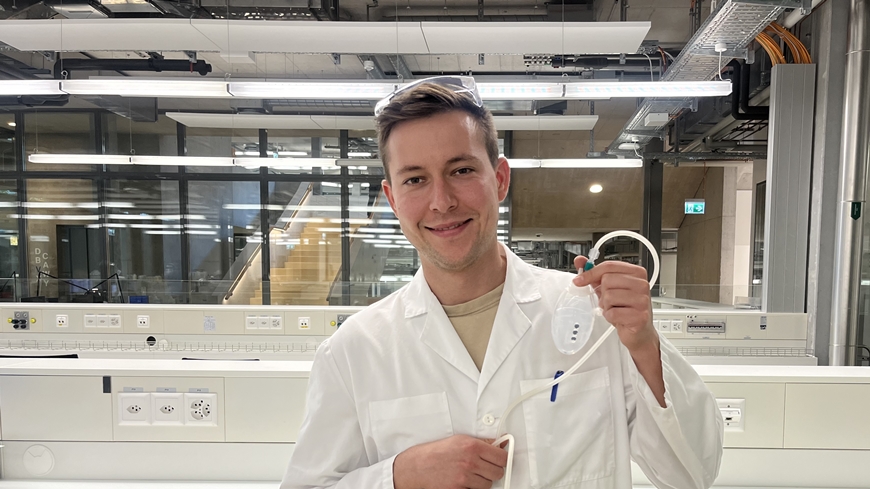Empa Innovation Award
Every other year since 2006 Empa presents its Innovation Award to outstanding innovation and technology transfer projects. The award can go to a single researcher, a group or a lab for an excellent innovation or successful transfer of technology to the private sector. Empa thus honors the efforts of its researchers to bridge the gap between science and industry with applied, market-oriented research. Currently spin-offs or industrial partners market the innovation and technology transfer projects that have won in the past.

Innovation Award 2024

The first prize of this year's “Empa Innovation Award” goes to a team of researchers from Empa and ETH Zurich for the “SensAL” sensor. “SensAL” warns quickly and precisely of life-threatening complications after abdominal surgery.
Team from Empa and ETH Zurich led by Alexander Jessernig, Alexandre Anthis and Inge Herrmann for their SensAL technology for the early detection of post-operative complications following abdominal surgery. The jury, consisting of experts from Empa and its Industrial Advisory Board, decided to award the prize to SensAL as an outstanding innovation and technology transfer project. And just a short time after the prize was awarded, the technology was also recognized at the Falling Walls Switzerland event. Due to the originality, patent strength and market potential of “SensAL”, the technology has also been nominated for this year's Spark Award from ETH Zurich.
Sensor protects against life-threatening complications of abdominal surgery.
Past winners
2022

The first prize of the year's "Empa Innovation Award 2022" went to an innovation on the pulse of time.
This 2022 winner is called "viboo." The Empa spin-off has developed a self-learning algorithm for more efficient control of the indoor climate in buildings, which can achieve energy savings of between 20 and 40 percent.
Empa Innovation Award 2022 for spin-off viboo: An innovation that helps save heating costs
2020

The "Empa Innovation Award 2020" went to a health technology that is retiring surgical sutures
Nanoglue is a novel tissue adhesive technology that promises faster and safer wound healing. It was developed by researchers at Empa's "Particles-Biology Interactions" Laboratory in St. Gallen in collaboration with the Nanoparticle Systems Engineering Lab at ETH Zurich. Their approach differs radically from existing solutions in that it uses the wound-healing properties of inorganic hybrid materials.
Inventions that improve our lives
2018

The Empa Innovation Award 2018 went to Francis Schwarze and the Empa spin-off MycoSolutions
The use of pesticides is still widespread in Swiss agriculture – and the resulting damage to humans and the environment is immense. The Empa spin-off MycoSolutions has developed a method that enables plants and wood materials to be naturally protected without the use of toxic substances. The company has been awarded this year's Empa Innovation Award for this successful transfer from the lab to industrial innovation.
Empa Innovation Award for spin-off MycoSolutions - Fighting pesticides in a natural way
2016

The Empa Innovation Award 2016 went to chemist Sabyasachi Gaan and his team.
The researchers were recognized for the development of new, non-toxic and environmentally friendly fireproofing agents for the production of flame retard polyurethane foams, which are used in mattresses, seat upholstery and insulation modules for house façades, for instance. The prize was awarded on 8 November against the backdrop of the Empa Technology and Innovation Forum.
Innovation Award for new flame retardant - Green chemistry fights fire
2014
Masoud Motavalli and a team from the “Structural Engineering” and “Joining Technologies and Corrosion” Labs won the award for the shape memory steel they developed as a new pre-stressing material for the building industry.
During the production of pre-stressed concrete, an initially unstressed steel cable or bar is subsequently stressed, which com - presses the concrete and gives it a greater load-bearing capacity. The Empa researchers devised a shape memory alloy based on inexpen - sive steel, which can be used for pre-stressing purposes, but also to reinforce structures retrospectively. Pre-stretched plates measuring five meters in length and 1.5 millimeters thick are attached to the underside of the concrete beams with the aid of special nails and electrified. Once the plates are hot, the steel alters its crystalline structure and tautens, which can generate lasting tensioning forces of up to 330 megapascals (330 newtons per square millimeter). The company re-fer, an Empa spin-off, sells and refines this technology. After successful tests, the first structures are scheduled to be pre-stressed with strips of shape memory steel in early 2017.
Shape memory steel as a new pre-stressing Material for the building industry
2012
Thomas Stahl, Samuel Brunner, Mark Zimmermann and Matthias Koebel received the Innovation Award for their spe cial super-insulating aerogel plaster, which they co-developed with the company Fixit AG.
There are 1.5 million old buildings in Switzerland and this building stock shapes city- and landscapes. However, 43 percent of the fossil fuels imported currently go on heating houses. A super-insulating plaster is, therefore, an ideal solution to renovate old buildings which can’t be (or may not be on heritage grounds) clad in thick polystyrene sheets, either inside or out. The special plaster developed by Empa contains the best insulating material that can be produced industrially: aerogel. Used in space travel, the material is extremely light and sensitive. Nonetheless, the Empa team succeeded in producing the plaster in such a way that it can be sprayed on with commercially available plastering machines. Fixit launched the product on the market in 2013 and mean - while sells it all over Europe in conjunction with its affiliates Röfix (Austria) and Hasit (Germany). Recent increases in aerogel produc - tion efficiency have enabled the prices to be halved, which is bound to boost the demand for the insulating plaster further.
2010
Michael Sauter and Gion Barandun, the founders of the Empa spin-off Compliant Concept, won the Innovation Award for their intelligent hospital bed.
Healthy people change position two to four times an hour while they are asleep. The elderly and sick move less frequently in their sleep, which may be down to paralysis, sleeping pills or painkillers they have been given or simply a lack of strength. As a result of this physical inactivity, the risk of bedsores (decubitus) – a painful con - dition that requires proper care – increases in a matter of hours. In nursing homes, immobile patients are, therefore, routinely turned several times a night. This is where the Mobility Monitor devised by Sauter and Ba - randun comes in: it helps reduce the burden on the nursing staff and avoids having to wake the patients unnecessarily – if they have moved themselves and no longer need to be turned. And if a patient ought to be turned after a certain time, the Mobility Monitor alerts the staff. By the same token, the device also recognizes wake-up phases and typical movement patterns before a patient wants to get out of bed, which helps prevent falls during the night. The new Sunnegarte dementia ward at Sunnewies nursing home in Tobel (Thurgau) became one of the first centers in the world to be equipped with Mobility Monitor beds. The comprehensive sleep monitoring system should improve the patient’s quality of sleep and pain monitoring.
2009
Josef Kaufmann, Jörn Lübben and Walter Trindler won the Innovation Award for novel bi-component fibers to increase the ductility of concrete, a popular building material, which can withstand extremely high pressures.
Unfortunately, it already gives out with low tensile loads. Only steel reinforcement helps here as it is able to absorb the tensile forces. Wherever it isn’t possible to embed large steel grids – such as in thin cellar walls, industrial floors, cement slabs, tunnel facings or window sills – concrete can be reinforced by adding steel fibers. However, these are heavy, expensive, harbor a serious risk of injury on account of their stiffness and can rust. In order to overcome these drawbacks, the Empa team developed a bi-component fiber. The fiber core consists of inexpensive polypropylene, the fiber sheath a special customized polymer which, chemically and mechanically speaking, is just the ticket for use in cement-bound materials. The product is currently sold by Brugg Contec AG in St. Gallen and used all over the world: tunnels in Austria, harbor installations in Poland and Singapore, industrial floors in Hungary, and hydroelectric power plants in Costa Rica are already capitalizing on Empa’s expertise in concrete research.
Novel bi-component Fibers for the Mechanical Reinforcement of Concrete
2008
Glauco Feltrin and his colleagues from the Empa spin-off Decentlab won the Innovation Award for wireless sensor network monitoring.
These networks consist of individual hubs and a base station. Every hub is a small, energy-saving computer equipped with various sensors, which register the surrounding conditions. The computer collects the data and radios it on to the nearest hub, which serves as a relay station. The base station is connected to the evaluating lab via the cellular network and supplies the data via an encrypted connection. The networks can easily be extended: every additional hub looks for a suitable relay station under its own steam and is, therefore, fit for immediate use. This also enables failed hubs to be bypassed. Decentlab sells and refines the technology. So far, wireless sensor networks have been used, among other things, in construction monitoring (movements in bridges, heat flows in buildings), forest and soil research, and air quality monitoring.
2007
Martin Amberg, Dirk Hegemann and Manfred Heuberger from the Advanced Fibers Lab were awarded the prize for metallized fibers with an unaltered textile character.
The globally unrivalled technique devised at Empa enables metals such as gold, silver, aluminum, stainless steel, copper or titanium to be “vapor-deposited” on the fibers at room temperature. Meanwhile, this kind of coated thread is produced by the company Serge Ferrari Tersuisse SA in Emmenbrücke near Lucerne; Swicofil AG (also based in Emmenbrücke) is in charge of sales and product development. The gold-coated fibers caused a sensation in the fashion industry with special applications – especially as the thread is soft, kind to the skin and machine-washable without compromising the coating. The company Roccoco Dessous sells lingerie embroidered with 24-carat gold threads in exclusive stores, and a new watch by the luxury brand Hublot boasts Empa’s gold thread on its face. However, electrically conductive metal threads are also used successfully in an industrial context. For instance, Swicofil developed a particularly durable brush made of gold fibers to conduct electrostatic charge away from machines while they are running.
2006
Felix Weber from the Structural Engineering Laboratory received the first Empa Innovation Award for the controlled damping of cablestayed bridges.
Wind and rain can cause the long stay cables on these bridge constructions to start vibrating like harp strings. As every bridge is unique and exposed to local weather conditions, not all of these vibrations can be predicted. Weber teamed up with the Munichbased company Maurer Söhne AG to develop a system that solves these problems: it involves measuring the vibrations and relaying them to an active damping element, which specifically absorbs the actual vibration. The system was installed on the Franjo Tudman Bridge in Dubrovnik in 2006. The following year, Maurer Söhne AG equipped the Sutong Bridge in China with it, at 1,088 meters the second longest cable-stayed building in the world. The controlled vibration damper for girder bridges is a progression of the cable damper. In conjunction with his industrial partner, the Empa researcher kitted out the 2,500-long Volgograd Bridge in Russia with the new system in the fall of 2011. Although it had only opened in 2009, it had to be closed again temporarily in 2010 due to severe vibrations.
Regulated damping system for cable-stayed bridges








